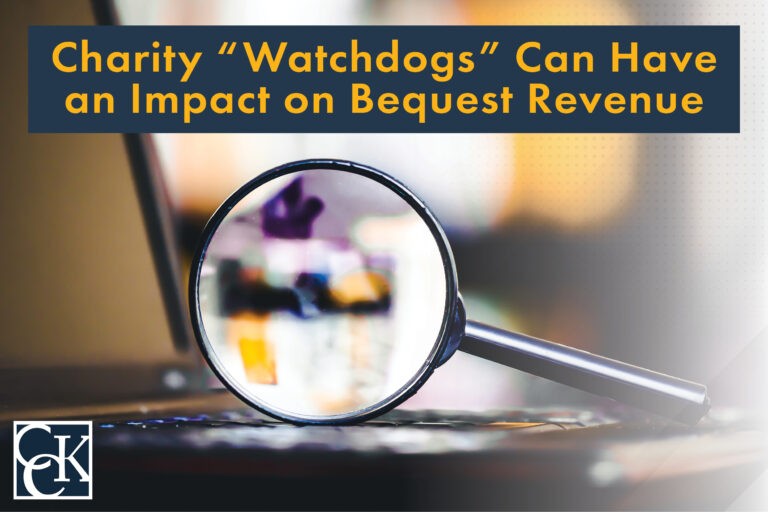Charity “Watchdogs” Can Have an Impact on Bequest Revenue

Charity “watchdogs” are omnipresent in the nonprofit world. These organizations, most of which are themselves tax-exempt, apply various standards and metrics to evaluate charities. Frequently, a watchdog’s analysis is distilled into a “star” rating (like the movies) or a letter grade (like school). The link between ratings and fundraising is difficult to quantify but impossible to deny.
At one time or other, nearly every major charity is going to seethe at a rating received from one or other of these watchdogs (there are only a handful of major ones, like the BBB Wise Giving Alliance, Charity Navigator, etc.). In those situations, organization executives often have a knee-jerk reaction to “go after” the offending evaluator. Before doing so, a charity should consider the six comments that follow.
1. Watchdogs Have Earned Donor Trust.
Statistics indicate that watchdogs influence a significant percentage of charitable giving, especially when large sums are involved. This means that planned giving representatives should be aware of any negative reviews of their organization and be ready to provide explanations or alternate reviews.
Oftentimes, estate planning clients ask their lawyers to “find me a reputable charity in the health care field.” In those cases, more likely than not, the attorneys will consult one or more of the established watchdogs. A good rating can secure a bequest. A bad one . . .
Takeaway: Charities cannot afford to ignore the watchdogs.
2. Most Watchdogs Will “Mediate” Application of their Standards.
Our staff has had extensive experience dealing with watchdogs. Most, but not all, will provide advance notice of a proposed review and rating, along with an explanation of any negative items.
Sometimes, through rational discussion, the charity and the watchdog can come to a mutually acceptable compromise. When attempting such a resolution, charities need to remember the old adage about flies, honey, and vinegar. A screaming, threatening tirade is not likely to accomplish the desired end.
Takeaway: A conciliatory approach with watchdogs will usually lead to a better result than antagonism.
3. In Some Cases, a Watchdog Will Offer an Opportunity to Cure.
Sometimes, a watchdog will “ding” a charity for something that can be easily fixed. A prime example is in the area of disclosures. In cause marketing advertisements, watchdog standards sometimes mandate the inclusion of specific information, such as the beginning and end dates of a promotion. If a charity slips up and fails to include this data, most (but not all) watchdogs will overlook noncompliance if the oversight is corrected quickly. Obviously, this works best when the charity is provided with advance notice of an unfavorable rating.
Takeaway: When a charity chooses to “mediate” with a watchdog, it is useful to be on the lookout for problems that can be addressed immediately.
4. The Standards Are Not Irrational.
The “standards” followed by watchdogs tend to be similar, but certainly not identical. Some rating services place emphasis on a particular metric that the others ignore.
An obvious area is the “cost allocation” for mail solicitations. Here’s the issue: Raising money by mail is an expensive proposition. A mail “package” can easily cost $2 or more per donor. Considering that campaigns involve hundreds of thousands or even millions of packages, the cost is enormous. If that entire cost is charged as a “fundraising cost” for accounting purposes, the charity’s “ratio” (fundraising expense as a percentage of revenue) will be skewed badly.
To prevent that, accounting rules permit the cost of certain kinds of informational materials in fundraising packages to count as ”program services” expenses rather than fundraising. All charities do this, and there’s absolutely nothing wrong with it. However, a minority of watchdogs evaluate charities “as if” that allocation had not been made. The result? Some charities, especially the bigger national variety, tend to be downgraded by the watchdogs that ignore “cost allocation.”
While the affected charities understandably object to that approach, it is not impossible that some donors would like to know the actual cost of expenditures that are primarily geared to fundraising.
Takeaway: A charity that is low-rated by a particular watchdog should think twice about attacking the standard(s) responsible for the negative evaluation. Chances are good that the standard is defensible. A better choice is to direct donors to a different watchdog.
5. Litigation Is Certainly Not the Answer.
Litigators in the nonprofit world all have “war stories” about charities that were ready to undertake legal battles against one or more watchdogs. Cooler heads appear to have prevailed and, to our knowledge, there has not been a serious effort in this direction.
We believe, except in a case where the watchdog was clearly “out to get” a particular organization, that such an effort would fail. Consider the case of the product rating service known as Consumer Reports (CR), which is a quality-focused watchdog for many kinds of products. CR has been sued several times by angry manufacturers whose products received negative ratings. In these cases, CR has been successful nearly 100% of the time.
Takeaway: Charities considering litigation against a watchdog should consider the litigation carefully. Weigh the “pros” and “cons.” After that, give up the litigation idea.
6. A Public Flogging Would Be Counter-Productive.
A poorly rated charity might also consider lashing out at a watchdog through a “bully pulpit” at its disposal, such as a widely-read website or journal. In addition to calling attention to the unfavorable rating, that counterattack could well prompt a case against the charity.
In our view, unless the charity had solid evidence that the watchdog had bad intentions (“legal malice”) in publishing the rating, the suit would not succeed. Even worse, the litigation itself could form the basis of a solid counterclaim by the watchdog for corporate defamation, abuse of process, or a similar cause of action.
Takeaway: A charity that attempts to turn public opinion against a particular watchdog is almost certainly setting itself up for a self-inflicted wound.